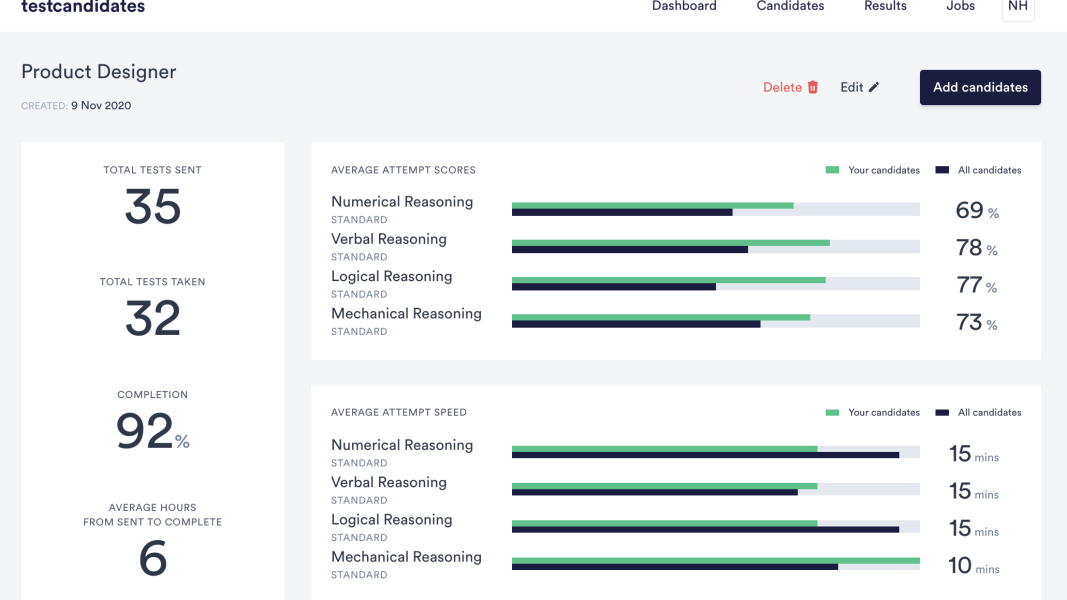The demands of the recruitment process have changed drastically in recent times. Investing money into screening resources might seem like a waste of limited funds, but it can have a long-term positive effect on productivity, the potential for growth, and hiring costs.
What Is Employment Screening?
Employment screening is the process of assessing how suitable a candidate is for the job, more traditionally known as 'background checks' or 'employee vetting'.
As the job market has changed over the last couple of decades, recruitment has become a much more resource-intensive process and for many companies, it can have a huge impact on productivity and their ability to grow.
In the current economy, an average job posting can garner hundreds of applications. So recruiters must ensure that they have made the right choice by carrying out pre-employment tests and checks.
Why Is Employment Screening Important?
By using employment screening resources, you can test candidates in ways that more accurately show how they would perform on the job and ensure they meet all the job requirements you have listed.
There are many more factors that impact whether someone is the right person, which you cannot ascertain from a CV, e.g. their preferred work style, career aspirations, and personal values. This is why employment screening is useful.
For some jobs, this may seem more obvious than for others. Sectors such as healthcare and education require employment screenings such as a DBS, which ensures that the person is suitable to work with children and other vulnerable groups.
Some checks are required by UK law; for example, it is an employer's responsibility to retain proof they checked that an employee has the right to work in the UK. If you do not have this, you can be fined up to £20,000.
Conversely, some laws work to prevent discriminatory screening questions and you must be able to prove that screening questions directly relate to the job. This is all-important to protect both employers and employees from bad workplace practices.
Beyond this, many people may question why it is no longer good enough to base an applicant solely on their CV, especially as adding more screening tools means more time and money spent on the process.
As millennials become the majority of working-age people, we are seeing the most highly educated workforce in human history, meaning that many people have similarly impressive qualifications and work experience which screening can help shortlist the top candidates who stand out.
Employment screening resources can fix a multitude of issues or inefficiencies in your recruitment process, but it may be difficult to know what exactly you are looking for. This guide goes through the main stages of recruitment and explains different screening tools, including what they are used for and why you would benefit from implementing them.
5 Employment Screening Resources You Should Know About
1. Online Application Forms
The first thing that potential candidates come into contact with is your application form, which means that this is where you make your first impression and can impact how many people submit their applications.
If the user experience is clunky or confusing then most people will simply give up. Many people now apply for jobs from their phones or on the go, so dealing with an application that is too long or not straightforward isn't worth the hassle.
It is also a waste of your time to not use this initial step to find out the necessary information about a candidate. By using a more tailored application form, rather than just a CV, you can make this step a lot more efficient.
Companies like JotForm offer application form templates and building services that mean you can customise your forms to get the most out of your applications. Places like Hire Hero also automate the process, of managing your job postings, sending out invitations, and scheduling, and provide an aesthetically pleasing platform for your job postings.
This helps you look professional and organised to candidates, who appreciate the effort put into managing the recruitment process and are more likely to finish their application.
2. Pre-Employment Testing
Aptitude testing is one of the most popular ways to screen applicants since it provides objective and easily comparable data, which can make it a lot easier to tell who to shortlist.
Our assessment platform is fully comprehensive and supports your process from inviting to analysing the reports. It includes aptitude, behavioral, and personality tests, which can give you a more complete profile of each candidate.
The automated actions also mean that it is efficient for you and applicants to use. Alerts and reports can be instantly created so the whole process is a lot smoother and faster, taking away frustration and human error.
3. Applicant Tracking
Using an Applicant tracking system (ATS) is one of the best methods for improving your candidate experience, something that can massively impact the quality of applicants and who accepts an offer to work for you. Automating this process will save time and resources, reducing frustration on both ends of the process.
The better ATS tools do much more than track applicants. They can also be used to schedule interviews, filter CVs for key information, and process referrals. Oracle's services, for example, include automated job postings, communication with candidates, interviews, and offers, and are designed with candidate experience in mind.
They also take into account how people use technology. Applicants can import LinkedIn profiles and the app is optimised for both desktop browser and smartphone use, making it easily accessible for everyone.
4. Video / Telephone Interview Tools
Remote interviewing is growing rapidly in popularity since it is much more accessible and less resource-consuming than in-person interviews.
As well as live interviews, some companies use asynchronous interviewing through resources such as HireVue. With this, candidates are asked to record answers to interview questions, which can be processed by an AI or a recruiter.
By using remote interviews you can increase the number of candidates that you can 'meet' and therefore get a better understanding of them, without having to go through the whole process of a face-to-face interview.
5. Criminal Background Checks
Background checks are the most common type of employment screening and therefore most employers are much more familiar with how they work. For standard checks like a DBS, the UK Government provides a service that helps with requesting a DBS and managing applications, as well as informing you of exactly what is legal and required for a job.
If you would like a more in-depth background check on your applicants, then there are plenty of services to choose from. Companies like Access have a wide range of screening packages, which are tailored for different sectors and can take away the stress of worrying about compliance or how exactly to do a proper background check.
Around 80% of their checks are automated, and a profile can be created for every candidate so you can easily and thoroughly analyze the collected data.
How Do You Introduce Screening Into Your Hiring Process?
Even after you have identified the areas of improvement you have in your recruitment process, it can still feel daunting to know where to start or how to introduce the changes.
One of the easiest ways to know what you need to do first is to talk to your current staff. Giving anonymous evaluation forms can be a great way of encouraging them to be honest about how they found the recruitment process and what they would change about it.
From this, you can decide where to start, whether by just implementing a new application form, online assessments, or improving your communication with candidates.
For most companies, a smart move is to sign up for a comprehensive talent management platform that creates reports and profiles, which can be easily tracked and compared as candidates move through the process.
By using these, you can decide which tools you want to use and can adjust your platform as you get feedback from candidates and your recruiters.







